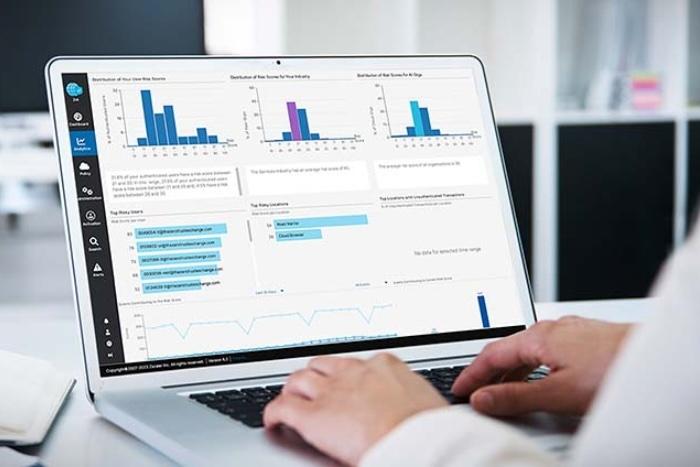Blog da Zscaler
Receba as últimas atualizações do blog da Zscaler na sua caixa de entrada
Inscreva-se
Outpace Attackers with AI-Powered Advanced Threat Protection
Securing access to the internet and applications for any user, device, or workload connecting from anywhere in the world means preventing attacks before they start. Zscaler Advanced Threat Protection (ATP) is a suite of AI-powered cyberthreat and data protection services included with all editions of Zscaler Internet Access (ZIA) that provides always-on defense against complex cyberattacks, including malware, phishing campaigns, and more.
Leveraging real-time AI risk assessments informed by threat intelligence that Zscaler harvests from more than 500 trillion daily signals, ATP stops advanced phishing, command-and-control (C2) attacks, and other tactics before they can impact your organization. In aggregate, Zscaler operates the largest global security cloud across 150 data centers and blocks more than 9 billion threats per day. Additionally, our platform consumes more than 40 industry threat intelligence feeds for further analysis and threat prevention. With ATP you can:
- Allow, block, isolate, or alert on web pages based on AI-determined risk scores
- Block malicious content, files, botnet, and C2 traffic
- Stop phishing, spyware, cryptomining, adware, and webspam
- Prevent data loss via IRC or SSH tunneling and C2 traffic
- Block cross-site scripting (XSS) and P2P communications to prevent malicious code injection and file downloads
To provide this protection, Zscaler inspects traffic—encrypted or unencrypted—to block attackers’ attempts to compromise your organization. Zscaler ThreatLabz found in 2023 that 86% of threats are now delivered over encrypted channels, underscoring the need to thoroughly inspect all traffic. Enabling protection against these threats takes just a few minutes in ATP in the Zscaler Internet Access management console. This blog will help you better understand the attack tactics ATP prevents on a continuous basis. We recommend you select “Block” for all policy options and set the "Suspicious Content Protection" risk tolerance setting to "Low" in the ATP configuration panel of the ZIA management console.
Prevent web content from compromising your environment
Threat actors routinely embed malicious scripts and applications on legitimate websites they’ve hacked. ATP policy protects your traffic from fraud, unauthorized communication, and other malicious objects and scripts. To bolster your organization's web security, the Zscaler ATP service identifies these objects and prevents them from downloading unwanted files or scripts onto an endpoint device via the user’s browser.
Using multidimensional machine learning models, the ZIA service applies inline AI analysis to examine both a web page URL and its domain to create Page Risk and Domain Risk scores. Given the magnitude of Zscaler’s dataset and threat intelligence inputs, risk scoring is not dependent on specific indicators of compromise (IOCs) or patterns.
Using AI/ML to analyze web pages reveals malicious content including injected scripts, vulnerable ActiveX, and zero-pixel iFrames. The Domain Risk score results from analysis of the contextual data of a domain, including hosting country, domain age, and links to high-risk top-level domains. The Page Risk and Domain Risk scores are then combined to produce a single Page Risk score in real time, which is displayed on a sliding scale.
This risk score is then evaluated against the Page Risk value you set in the ATP configuration setting (as shown below). Zscaler will block users from accessing all web pages with a Page Risk score higher than the value you set. You can set the Page Risk value based on your organization’s risk tolerance.
Disrupt automated botnet communication
A botnet is a group of internet-connected devices, each of which runs one or more bots, or small programs, that are collectively used for service disruption, financial or sensitive information theft via distributed denial-of-service (DDoS) attacks, spam campaigns, or brute-forcing systems. The threat actor controls the botnet using command-and-control software.
Command & Control Servers
An attacker uses a C2 server to send instructions to systems compromised by malware and retrieve stolen data from victim devices. Enabling this ATP policy blocks communication to known C2 servers, which is key to preventing attackers from communicating with malicious software deployed on victims’ devices.
Command & Control Traffic
This refers to botnet traffic that sends or receives commands to and from unknown servers. The Zscaler service examines the content of requests and responses to unknown servers. Enabling this control in the ATP configuration blocks this traffic.
Block malicious downloads and browser exploits
Malicious Content & Sites
Websites that attempt to download dangerous content to the user's browser upon loading a page introduce considerable risk: this content can be downloaded silently, without the user's knowledge or awareness. Malicious content could include exploit kits, compromised websites, and malicious advertising.
Vulnerable ActiveX Controls
An ActiveX control is a software program for Internet Explorer, often referred to as an add-on, that performs specific functionality after a web page loads. Threat actors can use ActiveX controls to masquerade as legitimate software when, in reality, they use them to infiltrate an organization’s environment.
Browser Exploits
Known web browser vulnerabilities can be exploited, including exploits targeting Internet Explorer and Adobe Flash. Despite Adobe sunsetting the browser-based add-on in January 2021, Flash components are still found embedded in systems, some of which may be critical for infrastructure or data center operations.
Foil digital fraud and cryptomining attempts
AI-Powered Phishing Detection
Phishing is becoming harder to stop with new tactics, including phishing kits sold on the black market—these kits enable attackers to spin up phishing campaigns and malicious web pages that can be updated in a matter of hours. Phishing pages trick users into submitting their credentials, which attackers use in turn to compromise victims’ accounts.
Phishing attacks remain problematic because even unsophisticated criminals can simply buy kits on the dark web. Threat actors can also update phishing pages more quickly than most security solutions meant to detect and prevent phishing can keep up with. But with Zscaler ATP, you can prevent compromises from patient zero phishing pages inline with advanced AI-based detection.
Known Phishing Sites
Phishing websites mimic legitimate banking and financial sites to fool users into thinking they can safely submit account numbers, passwords, and other personal information, which criminals can then use to steal their money. Enable this policy to prevent users from visiting known phishing sites.
Suspected Phishing Sites
Zscaler can inspect a website’s content for indications that it is a phishing site, and then use AI to stop phishing attack vectors. As part of a highly commoditized attack method, phishing pages can have a lifespan of a few hours, yet most phishing URL feeds lag 24 hours behind—that gap can only be addressed by a capability able to stop both new and unknown phishing attacks.
Spyware Callback
Adware and spyware sites gather users’ information without their knowledge and sell it to advertisers or criminals. When “Spyware Callback” blocking is enabled, Zscaler ATP prevents spyware from calling home and transmitting sensitive user data such as address, date of birth, and credit card information.
Cryptomining
Most organizations block cryptomining traffic to prevent cryptojacking, where malicious scripts or programs secretly use a device to mine cryptocurrency—but this malware also consumes resources and impacts performance of infected machines. Enabling “Block” in ATP’s configuration settings prevents cryptomining entering your environment via user devices.
Known Adware & Spyware Sites
Threat actors stage legitimate-looking websites designed to distribute potentially unwanted applications (PUA). These web requests can be denied based on the reputation of the destination IP or domain name. Choose “Block” in ATP policy configuration to prevent your users from accessing known adware and spyware sites.
Shut down unauthorized communication
Unauthorized communication refers to the tactics and tools attackers use to bypass firewalls and proxies, such as IRC tunneling applications and "anonymizer" websites.
IRC Tunneling
Internet Relay Chat (IRC) protocol was created in 1988 to allow real-time text messaging between internet-connected computers. Primarily used in chat rooms (or “channels”), the IRC protocol also supports data transfer as well as server- and client-side commands. While most firewalls block the IRC protocol, they may allow SSH connections. Hackers take advantage of this to tunnel their IRC connections via SSH, bypass firewalls, and exfiltrate data. Enabling this policy option will block IRC traffic from being tunneled over HTTP/S.
SSH Tunneling
SSH tunneling enables sending data with an existing SSH connection, with the traffic tunneled over HTTP/S. While there are legitimate uses for SSH tunnels, bad actors can use them as an evasion technique to exfiltrate data. Zscaler ATP can block this activity.
Anonymizers
Attackers use anonymizer applications to obscure the destination and content they want to access. Anonymizers enable the user to bypass policies that control access to websites and internet resources. Enabling this policy option blocks access to anonymizer sites.
Block cross-site scripting (XSS) and other malicious web requests
Cross-site scripting (XSS) is an attack tactic wherein bad actors inject malicious scripts into otherwise trusted websites. XSS attacks occur when a threat actor uses a web app to send malicious code, usually in the form of a client-side script, to a different end user.
Cookie Stealing
Cookie stealing, or session hijacking, occurs when bad actors harvest session cookies from users’ web browsers so they can gain access to sensitive data including valuable personal and financial details they in turn sell on the dark web or use for identity theft. Attackers also use cookies to impersonate a user and log in to their social media accounts.
Potentially Malicious Requests
Variants of XSS requests enable attackers to exploit vulnerabilities in a web application so they can inject malicious code into a website. When other users load a page from the target web server in their browser, the malicious code executes, expanding the attack exponentially.
Prevent compromise via peer-to-peer file sharing
P2P programs enable users to easily share files with each other over the internet. While there are legitimate uses of P2P file sharing, these tools are also frequently used to illegally acquire copyrighted or protected content—and the same content files can contain malware embedded within legitimate data or programs.
BitTorrent
The Zscaler service can block the usage of BitTorrent, a communication protocol for decentralized file transfers supported by various client applications. While its usage was once pervasive, global torrent traffic has decreased from a high of 35% in the mid-2000s to just 3% of all global internet traffic in 2022.
Tor
Tor is a P2P anonymizer protocol that obscures the destination and content accessed by a user, enabling them to bypass policies controlling what websites or internet resources they can access. With Zscaler ATP, you can block the usage of the Tor protocol.
Avoid VOIP bandwidth overutilization
While convenient for online meetings, video conferencing tools can be bandwidth-intensive. They may also be used to transfer files or other sensitive data. Depending on both your organization's risk tolerance level and overall network performance, you may want to curtail employee or contractor use of Google Hangouts.
Google Hangouts
While VOIP application usage may be encouraged for cost savings over traditional landline-based communications, it’s often associated with high bandwidth usage. Google Hangouts (a.k.a. Google Meet) requires a single video call participant to meet a 3.2 Mbps outbound bandwidth threshold. Inbound bandwidth required starts at 2.6Mbps for two users and expands with additional participants. In Zscaler ATP, you can block Google Hangout usage to conserve bandwidth for other business-critical applications.
Comprehensive, always-on, real-time protection
Clearly, there’s a wide swath of protection modern organizations need to fortify their security posture on an ongoing basis. Zscaler Advanced Threat Protection delivers always-on protection against ransomware, zero-day threats, and unknown malware as part of the most comprehensive suite of security capabilities, powered by the world's largest security cloud—all at no extra cost to ZIA customers.
ATP filters and blocks threats directed at ZIA customers and, in combination with Zscaler Firewall and Zscaler Sandbox, provides superior threat prevention thanks to:
A fully integrated suite of AI-powered security services that closes security gaps and reduces risks left by other vendors’ security tools. Zscaler Sandbox detects zero-day malware for future-proof protection while Zscaler Firewall provides IPS and DNS control and filtering of the latest non-web threats.
Real-time threat visibility to stay several steps ahead of threat actors. You can’t wait for another vendor’s tool to finish scheduled scans to determine if you’re secure—that puts your organization at risk. Effective advanced threat protection from Zscaler monitors all your traffic at all times.
Centralized context and correlation that provides the full picture for faster threat detection and prevention. Real-time, predictive cybersecurity measures powered by advanced AI continuously give your IT or security team the ability to outpace attackers.
The ability to inspect 100% of traffic with Zscaler’s security cloud distributed across 150 points of presence worldwide. Operating as a cloud-native proxy, the Zscaler Zero Trust Exchange ensures that every packet from every user, on or off-network, is fully inspected with unlimited capacity—including all TLS/SSL encrypted traffic.
Learn more about how Zscaler prevents encrypted attacks and best practices to stop encrypted threats by securing TLS/SSL traffic: download a copy of the Zscaler ThreatLabz 2023 State of Encrypted Attacks Report.
Esta postagem foi útil??
Receba as últimas atualizações do blog da Zscaler na sua caixa de entrada
Ao enviar o formulário, você concorda com nossa política de privacidade.




